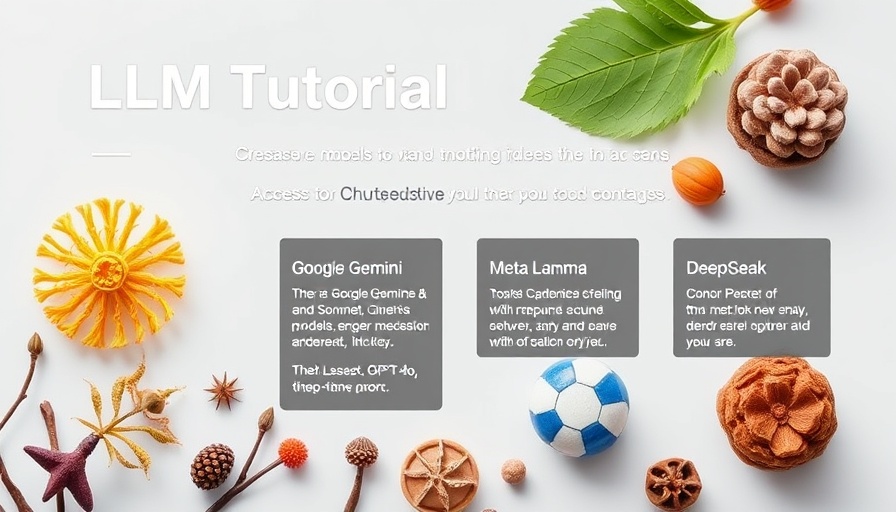
The Future of AI Access: Discovering Open Router
In a rapidly evolving digital landscape, artificial intelligence systems are becoming more integral to various sectors, driving efficiency and innovation. The video How to use Openrouter (Access Every LLM At Once) introduces us to Open Router—a pioneering platform that consolidates over 300 large language models (LLMs) into one accessible interface. For anyone engaged in AI technology, understanding how to leverage such tools is crucial.
In How to use Openrouter (Access Every LLM At Once), the discussion dives into accessing multiple AI models seamlessly, exploring key insights that sparked deeper analysis on our end.
Why Open Router Stands Out
Open Router is regarded as one of the best-kept secrets in the AI realm. Unlike other platforms, it’s designed to allow users to interact with different AI models simultaneously, providing a comparative analysis that can be invaluable for marketers, researchers, and content creators. The model selector, featuring recent releases, enables users to tap into the latest AI advancements efficiently. With descriptions accompanying each model, users can easily understand functionality and compatibility.
Maximizing Efficiency with Multi-Model Interaction
The true power of Open Router lies in its ability to connect users with multiple models in real-time. Imagine inputting a request and receiving responses from various AI engines like GPT-4.1 and Claude 3.5, simultaneously. This feature empowers users to evaluate which model offers the best responses based on their industry-specific needs. Marketers can refine their content strategies, while developers can streamline their coding queries, allowing for a more customized and effective workflow.
Cost-Effective Access to Revolutionary Tech
While some AI platforms impose costly subscription fees, Open Router operates on a pay-as-you-go model. Starting with a mere dollar or two, users can fund their interactions with premium AI systems. This affordability makes advanced AI technology accessible to a broader audience, minimizing barriers for startups and small businesses eager to harness AI capabilities. Furthermore, the model adaptability allows users to scale their operations without incurring fixed expenses.
User-Centric Features for Beginners and Experts Alike
Open Router caters to all skill levels. Beginners are guided through a user-friendly interface, while advanced users can tweak parameters like the temperature for improved creativity. The platform facilitates customizable system prompts, enhancing user engagement by directing how models respond based on specific needs. For seasoned professionals, exploring the sampling parameters offers deeper insights into model outputs, fostering innovation in approaches to problem-solving.
Insightful Trends and User Rankings: What Works Best?
Open Router doesn’t just allow users to communicate with various models; it also tracks their popularity and effectiveness across categories like programming, marketing, and finance. By analyzing market share and user ratings, individuals and teams can make informed decisions on which AI models to invest their time and resources in. These rankings highlight which models are gaining traction, ensuring that users always work with the most relevant technology.
Transforming Ideas into Reality: Steps for Implementation
To effectively incorporate Open Router into your workflow or business processes, start by identifying specific AI needs you aim to address. Whether crafting marketing copies or developing software, select the models that cater to your requirements. Subscribe to the platform, familiarize yourself with its layout, and begin experimenting with queries. Gradually refine your approach based on response analytics and user feedback, enabling you to maximize the potential of each interaction.
Anticipating AI Developments: The Road Ahead
The future of AI technology is intertwined with platforms like Open Router. As more businesses begin to recognize the advantages of integrated, multi-model solutions, we can expect to see increased competition among AI providers. This competition will likely lead to enhanced features, improved interfaces, and the development of specialized models tailored for niche markets.
In the rapidly approaching future, the continued exploration and adoption of tools like Open Router are essential for staying ahead in fields where AI integration is no longer optional but fundamental to success. By embracing these innovations today, we can actively participate in the evolution of technology that is shaping tomorrow.
If you're ready to harness the power of AI tools like Open Router, now is the time to start exploring how these technologies can redefine your professional endeavors.
 Add Row
Add Row  Add
Add 




Write A Comment